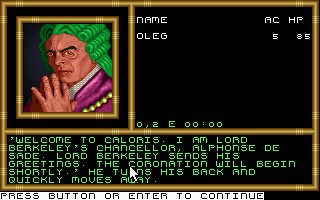
Author: GN Team - Published: 14 August 2018, 3:41 pm
Buck Rogers: Matrix Cubed is a sci-fi RPG developed by SSI and released for DOS only in 1992. It's the sequel to Buck Rogers: Countdown to Doomsday.
The game uses the so-called Gold Box engine, used in Pool of Radiance, Champions of Krynn, and many other games, including the predecessor. The engine and the game mechanics were starting to be a bit outdated for 1992, but the fans appreciated the great atmosphere, the graphics, and the connection with the tv series Buck Rogers in the 25th Century. It's a pity that the Amiga version, already programmed and reviewed in magazines, has never been released.
Read More
Author: Tasha - Published: 13 August 2018, 3:32 am
Alien Breed: Special Edition ‘92 is the enhanced remake of the original Alien Breed and was developed and published by Team 17 in 1992. It was released for Amiga only.
This remake of the original improves upon it greatly, including 12 new levels, while keeping the gameplay intact. The maps also keep their maze-like structure, and the game still features an overhead view of the environment.
For those unfamiliar with the series, Alien Breed was inspired by the Alien series of movies starring Sigourney Weaver. After trying to head home from your patrol of infinite space, you are sent on a mission to investigate a research facility that has gone dark. Because nothing terrible ever happens when people do that. Once there, you quickly discover the place is overrun with aliens. Taking gun in hand, it’s up to you to do a little extermination.
Read More
Author: Tasha - Published: 13 August 2018, 3:00 am
Theme Park is a strategy game about running your amusement park, developed by Bullfrog Productions. It was published by Electronic Arts in 1994 for Mac, 3DO, Amiga, and DOS. It was ported to several other platforms over the years, including the one I initially played it on, Sega Genesis.
Theme Park puts you at the helm of your entertainment park. You aim to build rides and other facilities, keep your guests happy, and increase profits. Starting, you need to pick your rides. They include the classics like haunted houses and water rides. Places to eat and purchase souvenirs are required to help you generate profit. You must also keep nice looking park grounds by installing water features and greenery. Employees are also essential to the smooth running of your facility, but you need to pay them fairly if you want them to work. Entrance fees to your park can’t get too high, or you’ll lose business. Rides will need to be serviced to keep them in working condition. Theme Park offers different modes that control the difficulty of the game and how many other things you need to worry about like research and stocks. Once your park is successful enough, you can sell it to the highest bidder and use that money to build new parks in other areas of the world. It’s like taking over the world, but with amusement parks.
Read More
Author: GN Team - Published: 12 August 2018, 1:40 pm
Backlash is a 3D shooter created by the British studio Novagen for the Atari ST in 1987 and ported to Amiga in 1988.
The game was programmed by Paul Woakes and designed by Bruce Jordan, the founders of the company. Novagen (and Woakes) are probably more famous for the Mercenary series, early examples of 3D games that were very appreciated on the Commodore 64.
Backlash is an endless shooter; you can move in all directions in this 3D (but flat) environment. You have to avoid obstacles and enemy fires, and try to kill as many aliens as possible.
Read More
Author: GN Team - Published: 8 August 2018, 12:06 pm
Network Q RAC Rally Championship is the sequel to the rally sim Network Q RAC Rally, developed by Magnetic Fields. It is also known in the US as "International Off-Road Racing".
This sequel was published in 1996, three years after the previous game, and was released for DOS and Windows.
With the right mix of arcade racing and sophisticated sim, the Rally Championship series stands somewhat in the middle between Need for Speed and Geoff Crammond's Grand Prix series. It was appreciated for the graphics, voiceover, weather conditions, and nightfall racing.
Read More
Author: GN Team - Published: 7 August 2018, 1:28 am
Not to be confused with Epic Games' fps, Unreal is a fantasy action game released by Ubi Soft for the Amiga in 1990. It was ported to DOS and Atari ST in 1991.
Unreal combines two different gameplays: the first part of the game is a pseudo-3d flying sim where you control a dragon; you need to avoid obstacles and use fireballs to destroy enemies. The second part of the game, definitely more appealing, is a 2d side-scrolling platformer/action adventure. The best aspect of Unreal is its atmosphere, created by the excellent graphics - created by Franck Sauer and Marc Albinet - and by the beautiful music and sounds. That's why many compared it with Shadow of the Beast, even though the two games are entirely different.
Read More